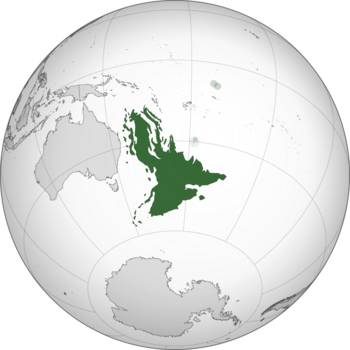Zealandia (Kaori)
Federal Republic of Zealandia | |
|---|---|
|
Flag | |
|
Motto: United We Stand | |
|
Anthem: "Vow to Zealandia" | |
 Location of Zealandia (in green) | |
| Capital | Wakefield |
| Largest city | New Utrecht |
| Official languages | English |
| Recognised national languages |
Dutch Punjabi Hokkien Cantonese |
| Protected languages | 20 indigenous languages |
| Ethnic groups (2020) |
67.4% European 17.8% Asian 11.5% Indo-Zealandians 3.3% Indigenous |
| Religion (2020) |
69.3% Christianity 15.9% Buddhism 12.5% Sikhism 2.5% Other/Non-Religious |
| Demonym(s) |
Zealandian Zeelander (historical) |
| Government | Federal constitutional assembly-independent directorial republic |
• Executive Council | TBA |
• President of the Diet | TBA |
• Chief Justice | TBA |
| Legislature | Federal Diet |
| Senate | |
| House of Representatives | |
| Independence from the United Kingdom | |
• Articles of Union | 17 May 1867 |
• Treaty of Vanois | 7 December 1895 |
• Home rule | 10 October 1949 |
• Constitution Act | 5 June 1953 |
| Area | |
• Total | 4,922,129.76 km2 (1,900,444.92 sq mi) (7th) |
• Water (%) | 5.57 |
| Population | |
• 2020 census | 130,823,919 |
• Density | 26.7/km2 (69.2/sq mi) |
| Gini (2023) |
29.6 low |
| HDI (2023) |
very high · 10th |
| Currency | tael (Ŧ) (ZTL) |
| Time zone | UTC+11 and +12 (ZWT and ZET) |
| Driving side | left |
| Calling code | +64 |
| Internet TLD | .zl |
Zealandia, officially the Federal Republic of Zealandia, is a country comprising the mainland of the Zealandian continent, several nearby archipelagos, and numerous islands. It is the second largest country in Oceania and the seventh largest country in the world by area, after Australia. Zealandia is a megadiverse country, consisting of a myriad of landscapes and climates, from the Tasman Mountains in the north to the Zuidveld in the southeast.
Worimi-speaking people arrived the continent roughly 45,000-40,000 years ago, from the nearby Australian continent. They settled in the northwestern portion of the continent and later formed 47 distinct linguistic groups, collectively known as the Kalkan, by the time of the first European arrivals, of which 16 survive to the modern day. Melanesians would settle the northeast approximately 20,000 years later, with contact between the Melanesians and Kalkan being well documented through cave paintings and oral traditions. Around the same time, Austronesian and Polynesians settlers arrived in the northeast and southeast. Due to the size and the mountainous topography of the continent, contact between the Austro-Polynesians and the Kalkan were nonexistent before the arrival of the Europeans. Zealandia's written history commenced with the arrival of Dutch settlers in the early 17th century. Dutch colonization began in 1610, with British colonization began with the end of the Napoleonic Wars in 1815 and subsequent annexation of the entire continent from the Dutch East India Company. The Zealandia Company would later takeover, forming the colony of New Zealand. By the mid-19th century, much of the continent had been explored and mapped, with an additional six self-governing charter colonies and four crown colonies being established. The four crown colonies and New Zealand formed a union in 1867. A series of wars would take place between the newly-united Dominion of Zealandia and the six self-governing charter colonies from 1875 to 1895, when the final colony was defeated and signed the Treaty of Vanois. After a series of civil conflicts within the newly-unified dominion, a series of compromises were reached, thus granting the six former colonies limited autonomy and establishing a new federal system. Conflicts between the interests of the Crown and Zealandia in the early and mid-20th centuries and the Second World War led to home rule being granted to the colony in 1949, with fully independence being granted in 1951. Zealandia would sever ties with the commonwealth two years later with the Constitution Act.
Zealandia is a federal constitutional assembly-independent directorial republic comprising six federal states, three federal territories, two indigenous provinces, and a capital territory, as well as other smaller offshore territories. The country's population of just over 130 million is highly urbanized and largely concentrated along the coastal areas in the northwest and south. Wakefield is the capital of the country, located within the capital territory of the same name. The largest city of New Utrecht was the former capital, and still serves as city of choice for most foreign embassies and consulates. Other major cities include Wellington, Southland, Zuidveld City, and Northshore. The country's abundant resources and well-developed trade relations are crucial to its highly diversified, robust economy. The government generates income primarily from the service, mining, and agricultural industries. Zealandia ranks highly in quality of life, health, economic and political freedoms, and education.
Zealandia has a highly developed and diversified market economy and one of the highest incomes per capita globally. It also has the fifth largest economy in the world by GDP, ranking below Japan and above Germany. The country is a middle power and has the 6th largest military expenditure in the world. Zealandia is member of various international organizations including the United Nations, World Trade Organization, APEC and South Seas Treaty Organization. The national currency is the tael, which also used in several neighboring island countries as legal tender.